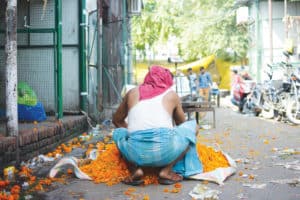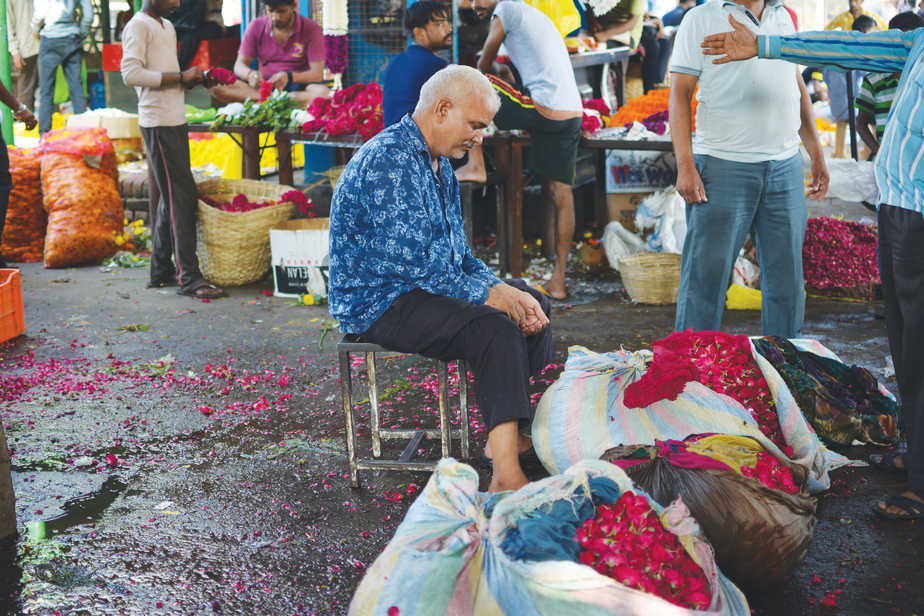The wholesale market for flowers at Ghazipur waits eagerly for the festive season, when demand goes up — and for the government to design a new structure that will attract tourists
Across the infamous landfill in Ghazipur sits a flower market duly authorised by DDA, on a terrain decorated with scattered debris from the landfill. A short walk from the main gate towards flora land brings relief from the stench of cowdung and rotting herbs (sounds like a formula?) littered outside the market. But no fragrance wafts across this wonderland — for that you have to bury your nose in a bunch of flowers.
As you approach the market, the sales boy at the first shop will reel off a list of every green sprig available at his shop in the name of organic decoration. “Madam, we have Fillis, Drycina, Fillsfool, Margineta, Victoria, Junipress, Karoten, Hareliya, Dandela, Aro keriya and Lal Jhumdi.” These are biological names articulated with a native accent, maybe difficult to decipher but you will feel proud that you recognise ‘money plant’, as he finishes his list with a flourish.

The market caters to the wholesale needs of the Delhi-NCR region. Flowers grown in various parts of India arrive early in the morning via trucks and flights. There is the delicate English rose and its various varieties and expensive substitutes of every other exotic flower that come from Bengaluru. And the indigenous species grown in parts of Uttar Pradesh, Rajasthan and Haryana. Marigold and mogra are available in such abundance that they are surely a staple in the market.
As Ganesh Chaturthi approached, the market was busier than ever, as women wove garlands for the deity and munshis placed bulk orders, counting out currency to seal the deal. Yet someone says, “Abhi toh manda hai. Deepawali ki baat hi kuchh aur hai (Business is low right now. Diwali is something else). A market that is supposed to be in full swing from 4 am looks busy even at 7 am, w supposed to be an off hour.
The area is divided into small lots of 5×10 square feet and given to flower contractors at Rs 2,500 per month apiece. Behind these cubicles you can spot a bunch of ladies sitting in circles, piercing marigolds with a need and thread to create a long trim for the upcoming festive season.
Asked if they enjoy making those flower frills, Sudha, a mother of five, sitting next to one of her daughters says, “We don’t earn any fixed income these days. The business will become better in November and December. If there is work, we end up earning Rs 4,000-5,000 a month, which is a good addition to my husband’s salary.” She adds that her kids join her when they don’t have school.

The rain seems to have left puddles in and around the maze of lanes where flower petals and dust have settled, emanating their own unique scent. But no, the sight of a man sitting cross-legged on a wooden bench amidst bundles of rotten roses with water trickling out of the ice gives a different explanation for the marshy ground. Pointing at the wet sacks of Indian roses, Ashok tells us that he didn’t receive good quality flowers this time, in the aftermath of untimely rain. He says the farmers of Kota told him that it won’t last for more than two days. “We are waiting for these flowers to dry so that they can be used for havan samagri,” adds the cross-legged man.
A little ahead sits an old man under a shed, who will call you if he sees you meandering around with your camera for too long. “Please ask what you want to know,” is his invitation for an interview. Shyaam Singh Saini is his name, his domain name —Saini flowers. Shop number 102, Ghazipur flower market. He continues with a formal introduction of the flowers that he has selling at his shop. “Gainda, Markee, Guldavari, and other loose flowers.”
His accountant, he says, comes at 2 in the morning to get the material unloaded. The buyers start coming in at 4-5 am, that is when the flowers are most expensive through the day. “They want the best flowers, that is those that can survive longer, and are ready to pay good money for such stock.”

According to Saini, son of a farmer who initially lived in the outskirts of Delhi, it is the effort one puts in every day that decides how much one earns in this business. A few years ago, he shifted to Ghazipur as government wanted to create a one-stop mandi for the floral requirements of the public —and one that could double up as a tourist attraction.
The shopkeeper shows us a variety of flowers like orchids from Thailand, that comes from abroad. “A lot of it comes from abroad but not as much goes out.” His hunch is that everything that grows in India gets used up in the country itself. If a farmer does business of Rs 15 lakh per month, the wholesaler’s share is around 10 per cent, explains Saini.
What makes flowers different from other perishable items is that at the end of they day, they decay and are discarded. “If the flowers go bad, then we sell it to these factories who make incense sticks and other aromatic products.”, reveals Saini. To go by his testimony, the rotting flowers are used in every product that has flower essence in it.
Non-profits have also smelt an opportunity to salvage something from this very perishable commodity. HelpUsGreen is one such initiative by Ankit Agarwal and Karan Rastogi that re-uses flower waste from temples on the ghats of the Ganga, which otherwise get thrown into the river, into soaps and incent products.

The market has been in the news lately, as its makeover was supposed to start in August. However, the land plan is yet to be approved by the concerned authorities. Saini’s information is that the government wanted multi-storey buildings, something that was suggested by florists who have seen such structures abroad. According to him, the extra cost of loading and unloading stock from ground floor to a different floor in the building will make the flowers more expensive. “In that case, shopkeepers on the ground floor will have a leverage.” He adds that a group of contractors from the market have sent a plan to the government for approval and hope that the decision will be made in their favour.
Fashion designer Amit Aggarwal even has a special space on his Instagram page for the Ghazipur flower market, with a series of photographs that capture the very essence of the place. It’s a visual treat but for a complete experience, you would have to go and smell the roses.
Hopefully, there will also be a solution to the mountains of garbage in the landfill in the vicinity, and a cleaning up of the approach road to the market. Such a place should have a fragrance, not smell.





